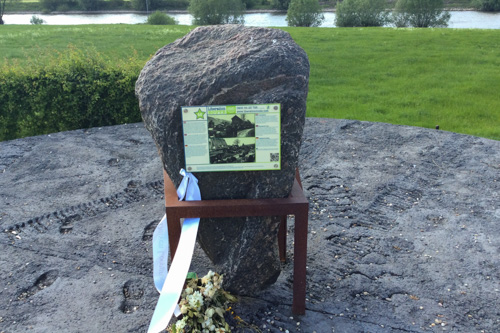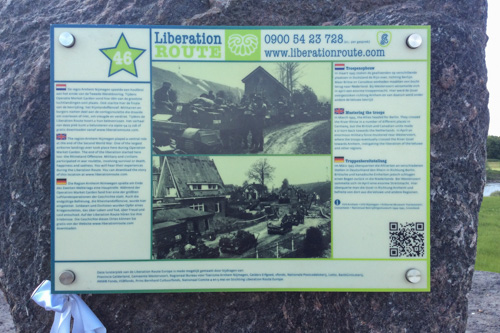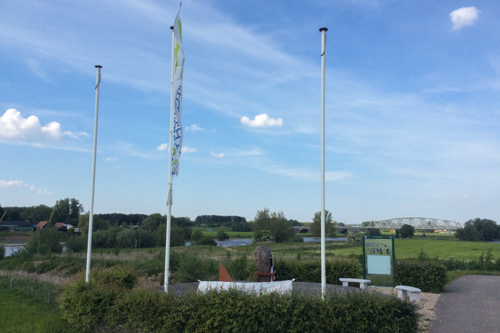Liberation Route Marker 046: Mustering the troops
Mustering the troops
In March 1945, the Allies headed for Berlin. They crossed the River Rhine in a number of different places in Germany, but the British and Canadian units made a U-turn back towards the Netherlands. An enormous military force mustered near Westervoort, where the troops eventually crossed the River IJssel towards Arnhem, instigating the liberation of the Veluwe region.
The allied attempts to conquer Arnhem seemed to be cursed. First there was the failure of Operation Market Garden in September 1944. Then on 2nd April 1945, the Allies tried to cross the Rhine from Driel in the Betuwe region, but the German defences on the other side of the river were very much on the alert, and the plan was aborted: the second time Arnhem was forced to wait for liberation. On 8th April, the allied troops moved to the east and crossed the Rhine, and into the Achterhoek region, using the pontoon bridges at Emmerich. This time, rather than coming in from the south, they came in from the east. It marked the start of Operation Anger, and the liberation of Arnhem.
Meanwhile, the German army had blown up the IJssel bridge between Arnhem and Westervoort and had entrenched themselves on the other side of the River IJssel, in Fort Westervoort and around the AKU artificial silk factory. The allied military force that was gathering well out of sight, near the village of Westervoort, was tremendous. Thousands of vehicles waited on the embankment by the bridge, ready to cross the river. Then on the evening of 12th April, the English artillery with hundreds of canons, starting firing at the German positions around Arnhem.
The Allies put up a smoke screen to help them cross the River IJssel undetected. The first troops crossed in boats and amphibious vehicles, and constructed a bridgehead on the other side. The German positions in Fort Westervoort soon surrendered, whilst the fighting at the AKU artificial silk factory, on the other hand, was extremely fierce and many were killed. Within fewer than 11 hours, the Allies had constructed the temporary bridge that had been shipped in from Doornenburg. The mass of tanks, carriers and armoured cars that had collected on the embankment was given the green light. On 14th April 1945, after heavy fighting, the Allies finally siezed control of Arnhem, and took the liberation of the Netherlands into its final phase.
Audiospot - Mustering the troops
Liberation Route Europe is a certified Cultural Route of the Council of Europe. With hundreds of sites and stories in nine European countries, the route links the main regions along the advance of the Allied Forces in 1943-1945.
The entire route consists of themed routes that can be travelled by by hiking, walking, cycling and car. These routes pass numerous historical and interesting sites and tell stories from a multitude of perspectives that were important in the final phase of World War II.
Many routes feature listening spots, offering the opportunity to listen to a historical story at a location. In addition, many ‘Vectors of Memory’ have been placed, indicating that the passer-by is on one of the Liberation Routes.
The routes can be found on the Liberation Route Europe website or in the app through which many stories can also be listened to.
Do you have more information about this location? Inform us!
Source
- Text: TracesOfWar & Liberation Route Europe
- Photos: Arjan Vrieze
Nearby
Museum
Point of interest
- Mural World War Two - Arnhem
- Former Fort Geldersoord - Westervoort
- Fragment of the Old Rhine Bridge - Arnhem
Monument
- Memorial Crossing to Liberation - Westervoort
- Memorial May 1940 - Arnhem
- War Memorial Westervoort - Westervoort
Cemetery
- Mass Grave Old Cemetery Huissen - Huissen
- Commonwealth War Grave Velp - Velp
- Dutch War Graves Catholic Cemetery Velp - Velp
Remembrance Stone
- Stumbling Stones Johan de Wittlaan 73 - Arnhem
- Stumbling Stones Emmastraat 65 - Arnhem
- Stumbling Stones Veerpolderstraat 46 - Arnhem






